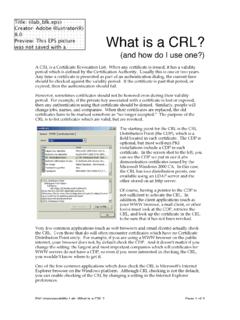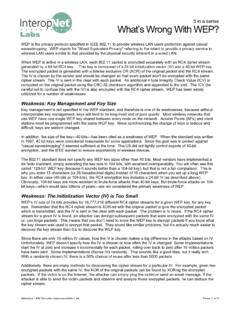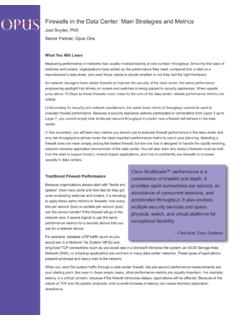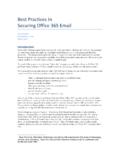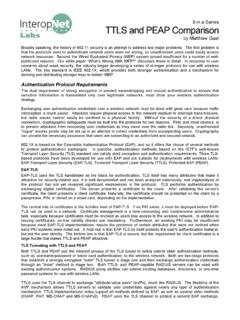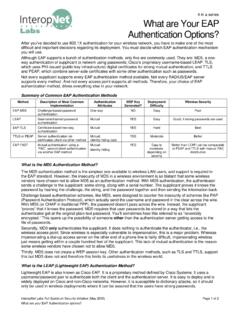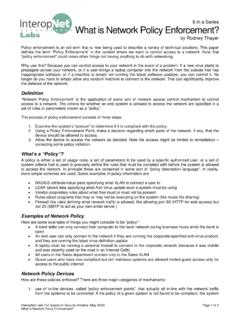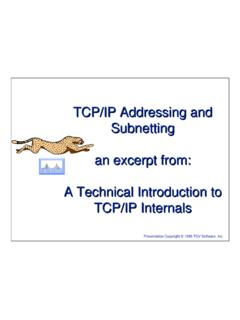Transcription of Six Strategies for Defense-in-Depth
1 INTRODUCTIONThe idea of perimeter defense when referring to a corporate network ignores com-mon knowledge: that most successful and significant security breaches don t come from the outside. Serious issues often originate inside the network: everything from worms, viruses, and Trojan horses to unsecured wireless networks, peer-to-peer mobile communications and guest users can compromise the security of corporate networks. To address these threats, the corporate network should no longer be a single homo-geneous zone in which users connect from anywhere in the network and receive the same levels of access. Instead, the network requires internal perimeterization and defenses. Regulatory requirements also demand stringent controls on data flow within the corporate network. Logging and auditing requirements put pressure at one end of the spectrum, while rules regarding disclosure and information sharing are pushing against the other side. In addition, the notion of a perimeter in a corporate network is fast disappearing.
2 While site-to-site and remote access VPNs are extending the perimeter, employees themselves are eroding the perimeter and making it weaker often without being aware of the impact they are having on network security. For example, a mobile employee who connects a laptop to the Internet from a mobile hotspot and is exposed to a worms or viruses can infect the corporate network when the employee returns to the office. The firewall that stopped the worm at the perime-ter is unable to stop this internal attack because it came from a trusted source. Simi-larly, an unsecured wireless access point (AP) in the corporate network can singularly jeopardize the security provided by the perimeter firewall. Six Strategies for defense -in-DepthSecuring the Network from the Inside Out J o e l S n y d e r2 Finally, mobility itself brings chaos to any network manager s attempt to segregate and segment traffic. Contractors and visitors require access to the Internet, while employees themselves move about within the campus connecting at different locations.
3 Seg-menting traffic based on source IP address is simply not enough in this environment, as a malicious client can easily assume another identity by changing its own IP address. The response to address the new security environment of corpo-rate networks is often referred to as Defense-in-Depth . The idea is to add protection at multiple layers rather than relying only on a perimeter firewall. Networks can no longer be partitioned into inside and outside. Defense-in-Depth requires that relationships between network re-sources and network users be a controlled, scaleable and granular system of permissions and access controls that goes beyond simply dropping firewalls between network segments. The Defense-in-Depth banner has been handy for all sorts of other security products, from IDS to virus scanners---certainly useful additions to a corporate network security plan. But few security architects have taken the idea of Defense-in-Depth to its logical conclusion: turn the network inside out.
4 MAKING A NETWORK SECURE: defense -IN-DEPTHD efense-in- depth is a dramatic departure from the transparent data corridor of the LAN. By pushing security into the network itself, the LAN changes from a public-access highway to a high-security network of roads, serving gated communities. Adding security into the LAN requires considering and implementing three key attributes of secure networking:Access control - knowing who is on the network (authentication), what resources they are authorized to use, and applying these access controls to their trafficIntegrity - guaranteeing that the network itself is available as a business critical resource and that threats can be identified and - ensuring that traffic on the network is not accessible to unauthorized is not a product, like a perimeter firewall. Instead, it is a security architecture that calls for the network to be aware and self-protective. In studying the problem of adding Defense-in-Depth , we ve identified six key Strategies that security architects can use to change significantly the security posture of enterprise wired and wireless LANs (WLANs): Strategy 1: Authenticate and authorize all network usersStrategy 2: Deploy VLANs for traffic separation and coarse-grained securityStrategy 3: Use stateful firewall technology at the port level for fine-grained securityStrategy 4: Place encryption throughout the network to ensure privacyStrategy 5: Detect threats to the integrity of the network and remediate themStrategy 6: Include end-point security in policy-based enforce-mentSTRATEGY 1: Authenticate and authorize all network usersThe starting point for any deployment of Defense-in-Depth is authentication.
5 Authentication should be handled at the earliest point of connection of the system to the network: at the port level, even before the client is assigned a network address. Associated with every positive authentication must also be authorization: now that we know who this person is, what does it really mean? What can they do? Where can they go? Unless every user in the authentication database has the same privileges and accesses, authentication must be tightly linked to authorization. The combination of positive authentication and user-based authorization information should form the basis for policy enforcement. Challenges in Authentication There are two key challenges in implementing network user au-thentication: the lack of a centralized authentication database, and the inability of some legacy systems to support modern protocols. The clear choice for network authentication is IEEE , the IEEE standard for network authentication. As an open ProblemWe don t know who is on our network Challenges Maintaining authentication databases for all types of users and systems; equipment that doesn t support authentication protocolsSolution Authenticate users (and perhaps devices) within the network, leveraging tools like , RADIUS and LDAP to provide both authentication and authorization information3standard with support for multiple authentication protocols, is flexible enough to support everything from digital certificates to username/password authentication, and plat-forms from low-end PDA devices and mobile phones up to desktop and server operating systems.
6 Has become a strong force and has already seen widespread adoption across network equipment manufactur-ers and operating system vendors Strategies for Deploying Authentication in NetworksThe obvious place to start deploying network-based au-thentication using is in the wireless network. As a replacement for simple WEP authentication, can be used by itself or in conjunction with WPA or secu-rity. Since wireless is becoming an obligatory technology for most buildings, adding both resolves the demand for wireless and offers the opportunity to get acquainted with the technology and the supplicant software is built into recent versions of both Windows and Macintosh operating sys-tems, testing supplicants (clients) is rarely a difficult process. However, other platforms, such as PDAs and particularly embedded wireless devices (such as wireless print servers), may present a challenge. Once there is experience with wireless deployments, it is time to move to wired device authentication.
7 Although a full roll-out will probably require some replacement of equip-ment, it is likely that there is hardware somewhere in the enterprise that can be used to begin wired testing and start deployment. Defense-in-Depth is successful only if authorization is imple-mented successfully following positive authentication. It is critical that a user s privileges on the network vary based not just based on their identity but also based on other intelli-gence about the user such as:(1) machine identity (2) security level of the machine (3) location of the user (4) time of day and (5) authentication methodFor example a user accessing email from a personal computer at home on the weekend may be given access to email only if the home PC is running appropriate version of the corpo-rate-approved firewall. In the event of non-compliance the user may be directed to a download site to download such software. An interesting use of location-based authorization is enabled by intelligent WLAN systems that can pinpoint the location of the user.
8 In such a scheme, a use can be prevented from accessing sensitive applications when sitting in the corporate , effective network security begins with authentica-tion at the earliest possible stage and with intelligent autho-rization. This combination of authentication and authoriza-tion should form the basis of security policy in corporate networks O T T O M B A RVirtual LANs extend the Ethernet standard by letting two different networks share the same wire. To keep the traffic separated, each frame from each network is tagged with a VLAN number. At either end of a physical link, devices such as switches or rout-ers know how to interpret the VLAN tags and break the traffic apart. End systems only see the traffic from the LAN they belong. In effect, what used to require two sets of equipment and two physical wires can now be done with a single set of VLAN-capable switches and approaches to security require authentication for all users prior to being granted network access.
9 Centralized policy management drives this new security architecture. Sophisticated new systems that central-ize security can now enforce user access based on location, device type and a myriad of other 2 Use VLANs for traffic separation and coarse-grained securityVLANs are, by their nature, unrouted chunks of network traffic. In most modern building networks, a fair amount of layer 3 IP routing takes place between wiring closets and the computer rooms. In a campus environment, routing is even more common. This makes pushing large numbers of VLANs around the infrastructure a fairly difficult-to-manage process. Although most networks are heavily over-engineered with Gigabit (or 10 Gigabit) trunks, carrying a large number of VLANs around the network to represent different security profiles can stress not only the infrastructure, but also the management of the network itself. This difficulty is com-pounded as WLANs are added to the network. To maintain simplicity, enable inter-SSID mobility and preserve the current IP addressing scheme, it is essential that the WLAN architecture of choice have the ability to enable multiple VLANs across a single SSID.
10 This is typically true of new generation of centralized WLAN solutions. Strategies for Security VLANsThe key to successful use of security VLANs is dynamic assign-ment. While some ports in the network can be hard wired to a particular VLAN (for example, in the server room or in the re-ception area of the company), assigning traffic to a VLAN should be done dynamically based on the authentication provided by the user (see Strategy 1, authenticate and authorize network users). Dynamic assignment is a critical requirement in building manageable networks. Static definition of security tends to cause long-term maintenance problems and impedes mobility of end users. By tying security to authentication information retrieved at the point of network access, secure networks can support quickly changing and moving user populations with minimum staffing are multiple ways to assign devices to VLANs dynamically, including: based on authentication information based on Web-based authentication information according to an SSID selected by the user in a wireless network based on detection of some other attribute, such as the MAC address of the device or the location of the userBringing dynamic assignment into the network requires a mechanism for providing authorization information at authen-tication time.
